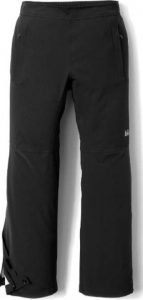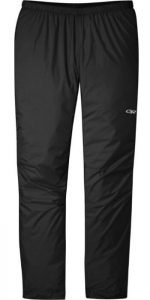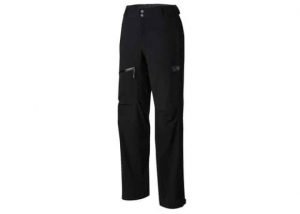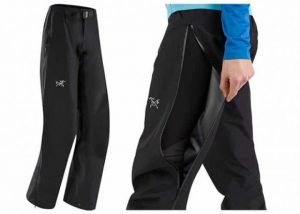For many, rain pants can be an afterthought when setting out on a hiking trip. You think, “Oh, the weather report looks good, I’ll just throw my rain coat in my pack and who uses rain pants anyway?”
Guess what? If you live and hike in a dry climate with barely any rain fall, you might be okay.
But maybe not. Mother Nature sometimes likes to affectionately teach us a thing or two about being prepared in the backcountry. You may find yourself caught in a sudden freak storm where your trusty rain jacket does a great job keeping your upper body dry, but your lower body is a cold, wet mess.
If you’ve decided you want to sport a new (or first) pair of women’s rain pants, you’ve come to the right place. This article covers the terminology and key considerations on how to choose rain pants and our top picks, helping you to stay happy and dry on your hiking escapades.
Terminology | Waterproof Layers | How to Choose | Best Picks
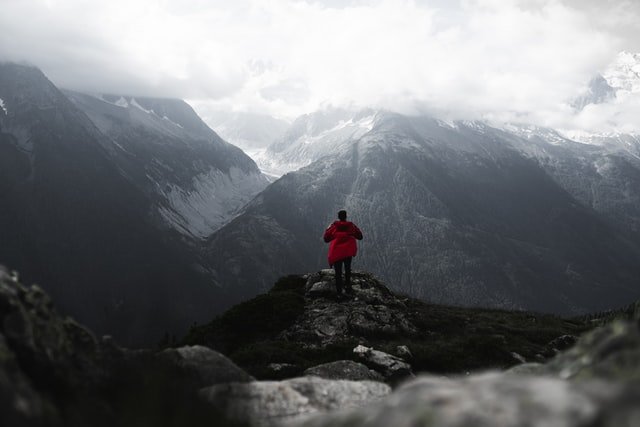
Terminology
Not all rain pants are created equal! This is why it’s super important to read the labels and know the differences in terminology, so you can choose what’s best for your wet weather protection.
To break it down: Water repellent, water resistant and waterproof are all distinctly different terms – they don’t mean the same thing, so don’t be fooled!
- Water Repellent means a material is coated with something to repel water, but it has its limits. When it gets wet, it creates beads of water on the outside offering some water protection, yet not much in a downpour.
- Water Resistant isn’t going to give you as much protection as repellent. The bottom line is that in a real dump of rain, you’re going to get pretty darn wet. The fabric cannot stop water molecules from infiltrating to your skin or clothing.
- Waterproof is the ultimate slayer against that evil storm, saying something like, “Haha, rain! You can’t get me!” The weave of waterproof fabrics doesn’t allow water molecules to penetrate. You can read more on waterproof ratings here.
What does all this mean when choosing a pair of rain pants? Well, the more waterproof your pants are, the more body heat you retain = you stay warm and dry even if it’s cold and damp out. It also means you stay more comfortable, you can hike more miles without having to stop to set up your tent to get dry and you stress less about whether you’re going to get hypothermia or not.
There can be a downside though to the seemingly wonderful term of being waterproof: It can mean less breathability. Waterproof gear doesn’t prevent you from dripping sweat all over the inside of your pants if you overheat due to physical exertion.
Some brands are addressing this concern with having created waterproof breathable rain pants. These fabrics prohibit rain drops from penetrating, but simultaneously allow moisture to escape from inside to the outside. Please note that no waterproof gear is completely breathable, yet these fabrics do a much better job AND technology is improving all the time.
Waterproof breathable sounds perfect, right? The price tag for these may make you think twice, yet this is where you consider the cost-benefit ratio of whether expensive gives you the high performance and peace of mind you want.
More Info on Waterproof Technology
Laminates and coatings are the two main types of waterproof technology.
- Laminates have thin membranes which block water from passing through, yet still allow vapor to pass. These membranes are usually very thin and are in between two other layers for protection. Bummers include being more costly and they can get damaged easily.
- Coatings have a waterproof layer that has been painted onto the interior side of the garment. As it’s painted on, tiny holes are put into the coating to make the material more breathable. How thick the coating is determines whether the material is lightweight or heavier.
Overall, coatings differ from laminates by breathability and price. Coatings tend to be less breathable, yet a bonus is they’re less expensive. Other essential factors such as durability and water-resistance depend more on the rain pants themselves than on the waterproof technology.
DWR:
DWR is code for “Durable Water Repellent” treatments. These treatments are applied to the outside of a material to help it shed water – think waters off a duck’s back. When you see water form into beads on your rain gear, this is the DWR doing its thing.
Most waterproof hiking pants have a DWR exterior and the laminate or coating are on the inside. These layers create increased breathability, abrasion-protection and water resistance.
It’s important to note that DWR is not the same thing as being waterproof. Yet DWR is often adequate enough for hiking and backpacking in places it doesn’t rain a lot or if it’s a warmer season and the rains are short and sweet. Not much water will be absorbed and the pants will dry quickly. You’ll have to reapply the DWR coating at dimension point, but DWR sprays are rather inexpensive.
Waterproof Layers
Waterproof materials come in layers of 2, 2.5, or 3. The number of layers plays a role in breathability, weight, water-resistance and durability.
- 2 Layer consists of an outer layer with a coating or membrane. 2-layer waterproof garments are usually cheap, but provide little protection against bad weather. You trade out the downsides of being less waterproof and not very durable with the upsides of being lighter and more packable.
- 2.5 Layer has a face fabric with a coating or membrane plus a non-fabric, protective film material on the inside. Advantages of these fabrics are how they’re light and pack small, while also offering solid weather protection. They’re a more affordable option, too.
- 3 Layer has a face fabric with waterproofing, a membrane and a liner. This is the cherry on the sundae in terms of giving the most protection and is highly durable. However, 3- layer is rather expensive, heavier and stiffer.
Breathability Ratings:
If you don’t want to be a hot mess while hiking in the rain, you really want to read this part. Breathability is rated in grams per square meter; this tells us how much vapor can pass through a square meter or material in 24 hours. Key point: The higher the rating equals the more breathable the material.
- 5,000 to 10,000 grams/m2: This is a pretty low amount of breathability, best for low physical activities – not a great choice for hiking.
- 10,000 to 15,000 grams/m2: This is a rather good level of breathability. If you’re hiking in a drier climate, this could work.
- 15,000 to 20,000 grams/m2: This level of breathability is optimal for high-humidity areas and circumstances where you’ll be sweating like a pig.
Waterproof Ratings:
- 5,000mm: For waterproofing, this is the base level – acceptable for light rains, but not okay for heavy or sustained downpours.
- 10,000mm to 15,000mm: This is a good level of waterproofing to aim for when shopping – it can withstand most rains and even some snow.
- 15,000mm to 20,000mm: If you plan to adventure in a very wet climate or region (or you just know it’s going to rain a lot), this is the level you want. And if you wear it with insulating layers, it can also work for winter months.
What Else is Important? Key Considerations When Choosing
Comfort
Make sure what you choose fits before you go out on a trip! It’s a good idea to buy a size bigger than your normal size, as you will likely be wearing your rain pants on top of another layer. Try them out at home with layers on first before you get outdoors and realize they’re too snug.
Also be sure you can move freely in your rain pants and you have mobility in your knees when you flex. You want to be able to get them on easily if a storm shows up suddenly, so look for pants with zippers or snaps.
Do you feel more comfortable with a drawstring or a clip waistband? Do you not like the feeling of something plasticky and rigid against your skin it there’s no base layer on you? These are definitely some things to consider in terms of choosing rain pants for comfort.
Price Tag
High quality rain pants can be costly; there’s no beating around the bush there. Cost-benefit ratio was mentioned earlier in terms of your willingness to spend the bucks if you really want top performance in the worst of conditions.
However, think about where you normally hike – does it rain a lot? Are you a fair weather hiker and only like to set out on a trip if you know the weather is going to be sunny? Sure, we all have to be prepared just in case, but a simple, affordable pair of rain paints may work for you depending on what’s your needs are. You don’t have to break the bank on a piece of gear you’ll only use once every blue moon. Get clear on what your needs and wishes are based on this article and you may find you don’t need the best on the market.
Weight and Packability
Rain pants used to be heavy and bulky items, but these days there are many options for lightweight rain pants that pack down small and function well for hiking and backpacking. Lightweight, minimalist pants can do the trick to give protection from light rain and wind.
Lightweight rain pants can be more expensive though, so unless you’re doing a long distance hike and really aim to cut back on weight, this may not be a big factor for you.
Durability
How tough do you need your rain pants to be? Are you going to be in areas with a lot of brush and overgrowth in the backcountry? Lightweight options can be less durable and not up to the wear and tear you need them to endure. If you plan to deal with harsh weather or rough terrain, you may opt to choose a thicker pair of ultra-tough rain pants.
Ventilation
Airflow is a darn good thing! Zippers not only make it easier to put on and slip off your rain pants, they add much needed ventilation to assist you thermoregulate when climbing that giant hill. Rain pants that have full-length zippers support the most airflow.
Some ultralight folks frown upon zippers because they add bulk and weight. To combat that, companies are making rain pants that breathe almost as well because they’re made with thinner materials.
It’s challenging to avoid getting steamy and sweating when you’re hiking hard in rain gear. Try to wait to put on your rain pants until you begin to feel chilly. You can also wear lightweight synthetic hiking pants, shorts, or a Merino wool base layer underneath. This will aid in moving moisture away from your skin and keep you a bit more comfortable while slogging along in the rain. Heat can be released by unzipping side zippers or making ankle cuff adjustments.
Upkeep and Care
Your rain pants are an investment and the more attention you put into caring for them, the longer they’ll last. Try using a wash-in product called Nikwax Tech Wash on your pants and jackets once they’ve been through the washing machine a few times, to help keep them waterproof or water resistant. Hang dry your rain gear and brush dirt off with a dry brush rather than wash it after each hike.
After it finishes raining on you while hiking, be sure to dry out your pants before storing them away -sounds like a no brainer, right?
The Best Women’s Rain Pants
Now we’re on to the good stuff. Based on all of the information above, here are our top picks for women’s rain pants.
Best Value –
REI Talusphere Rain Pants
Price: $53.69 (REI)
Features/Pros & Cons:
- 2.5 Layer Element waterproof material
- Windproof
- Good fit and mobility with stretchy material
- Two pockets
- Drawstring waist + elastic
- Nice fit
- Legs unzip to mid-calf for ventilation, can put on and take off with ease, zip is covered to stop leakage
- Affordable
- Not the most breathable choice
Best Affordable Ultralight –
Outdoor Research Helium
Price: $119 (REI) (Also on Amazon)
Features/Pros & Cons:
- 2.5-layer Pertex Shield+ material which features a 30-denier ripstop face fabric and a polyurethane membrane.
- Good breathability at 20000g/m2
- Super lightweight at around 6 ounces (depending on size chosen)
- More durable than most lightweight rain pants
- Packs very small
- Taped seams for more weather protection
- Has ankle zippers which offer limited ventilation and hard to take off/put on fast due to short zippers
- One zippered pocket, gusseted crotch
- Elastic waist with a drawcord
- Mid-range in price
See On Amazon | See On REI | See On Outdoor Research
Best Choice for Overall Comfort & Function –
Mountain Hardware Ozonic Stretch Waterproof Women’s Hiking Pants
Price: $112-252 (depends on size) (Amazon and Backcountry.com)
Features/Pros & Cons:
- Dry Q Active material – waterproof and breathable technology that banishes moisture while being tough, durable, and abrasion-resistant
- Full length side zippers for easy on/off. Side zippers have two security closures, a Velcro tab at the waist and a snap tab at the ankle.
- The 4-way all-over soft, comfy stretch fabrication and enhanced knee articulation allow for high range of motion. Made with elastic in the back waist to increase flexibility.
- Adjustable webbing belt
- Solid ratio of waterproofness (20,000) to breathability (15,000)
- Can be pricey depending on size
- A bit heavier and bulkier than ultralight options, weighing at 10 ounces
- Limited pocket storage
See On Amazon | See On REI | See On Backcountry
Best Quality for Technical Use –
Arc’teryx Zeta SL Waterproof Women’s Hiking Pants
Price: $186.89 (REI) – on sale now, usually $249
Features/Pros & Cons:
- Gore-Tex 3-layer
- Gore C-Knnit backer technology for lighter weight and breathability
- Zippers: Side zipper & zippered fly, cuff-to-thigh zippers for ventilation and easy on/off, high-quality and waterproof
- Gusseted crotch, articulated seat and knee
- Flattering fit
- Rather light (9 ounces) for a heavy-duty, durable pair
- Packs down well
- Not as expensive as some other technical options (but more of an investment purchase overall)
- Very waterproof and breathable
- No pocket
See On Amazon | See On REI | See On Arcteryx
Lightest Rain Pants
Zpacks Vertice
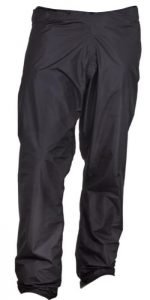
Zpacks Vertice
Price: $149 (Zpacks)
Features/Pros & Cons:
- One of the the lightest options out there at 2.8 ounces
- Extra wide legs for increased airflow and somewhat easy on/off, yet still not as easy as other pairs with zippers and you’ll probably have to remove your shoes
- Packs down small
- Delivery time is 3-4 weeks which can be considered a con if you need them soon for a trip
- Thin materials are less durable
- No pockets
- Not a budget choice (yet not a deal breaker either)
The Wrap-Up
There are many factors to consider when choosing rain pants, but you can easily narrow down your scope when you first determine what’s important to you. It’s a good idea to be prepared with something for rain while on a hike and there’s a pair of rain pants out there for every woman’s budget and preferences.
For the record: It would be awesome to see more choices in colors for a bit of flair and fun while tramping around in those puddles! There’s nothing like some hot pink, fire engine red or sunflower yellow to cheer you up (at least a little) during a downpour.
Happy Hiking, rain or shine!
Heather Rideout has been a life-long outdoors woman. Her pursuits and passion with hiking and camping have taken her around the world for many long distance trips; such as backpacking in Nepal, India, South America, Morocco, Europe, and North America. Heather has hiked the Appalachian Trail, 2,250 miles of the Pacific Crest Trail, and a route of 1,500 miles combining several Camino routes through Spain and Portugal. She has been a blogger for ‘The Trek,’ and recorded an episode with one of her outdoor stories for the podcast ‘Out There.’ Heather shares some of her writing on her website, www.wanderyoga.com

